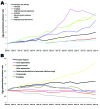Increasing hospitalizations and general practice prescriptions for community-onset staphylococcal disease, England
- PMID: 18439352
- PMCID: PMC2600225
- DOI: 10.3201/eid1405.070153
Increasing hospitalizations and general practice prescriptions for community-onset staphylococcal disease, England
Abstract
Rates of hospital-acquired staphylococcal infection increased throughout the 1990s; however, information is limited on trends in community-onset staphylococcal disease in the United Kingdom. We used Hospital Episode Statistics to describe trends in hospital admissions for community-onset staphylococcal disease and national general practice data to describe trends in community prescribing for staphylococcal disease. Hospital admission rates for staphyloccocal septicemia, staphylococcal pneumonia, staphylococcal scalded-skin syndrome, and impetigo increased >5-fold. Admission rates increased 3-fold for abscesses and cellulitis and 1.5-fold for bone and joint infections. In primary care settings during 1991-2006, floxacillin prescriptions increased 1.8-fold and fusidic acidprescriptions 2.5-fold. The increases were not matched by increases in admission rates for control conditions. We identified a previously undescribed but major increase in pathogenic community-onset staphylococcal disease over the past 15 years. These trends are of concern given the international emergence of invasive community-onset staphylococcal infections.
Figures


Comment in
-
Increased hospitalizations of elderly patients.Emerg Infect Dis. 2008 May;14(5):847-8. doi: 10.3201/eid1405.080218. Emerg Infect Dis. 2008. PMID: 18439380 Free PMC article.
References
-
- Projan SJ, Novick RP. The molecular basis of pathogenicity. In: Crossley KB, Archer GL, editors. The staphylococci in human diseases. New York: Churchill Livingstone; 1997. p. 55–81.
-
- Lee PK, Weinberg AN, Swartz MN, Johnson AR. Pyodermas: Staphylococcus aureus, Streptococcus, and other gram-positive bacteria. In: Freedberg IM, Eisen AZ, Wolff K, Austen KF, Goldsmith LA, Katz S, editors. Fitzpatrick’s dermatology in general medicine. London: McGraw-Hill; 2003. p. 2182–207.
-
- Brown J, Shriner DL, Schwartz RA, Janniger CK. Impetigo: an update. Int J Dermatol. 2003;42:251–5. - PubMed
-
- Baddour LM. Cellulitis syndromes: an update. Int J Antimicrob Agents. 2000;14:113–6. - PubMed
Publication types
MeSH terms
Substances
Grants and funding
LinkOut - more resources
Full Text Sources
Other Literature Sources
Medical
Miscellaneous
